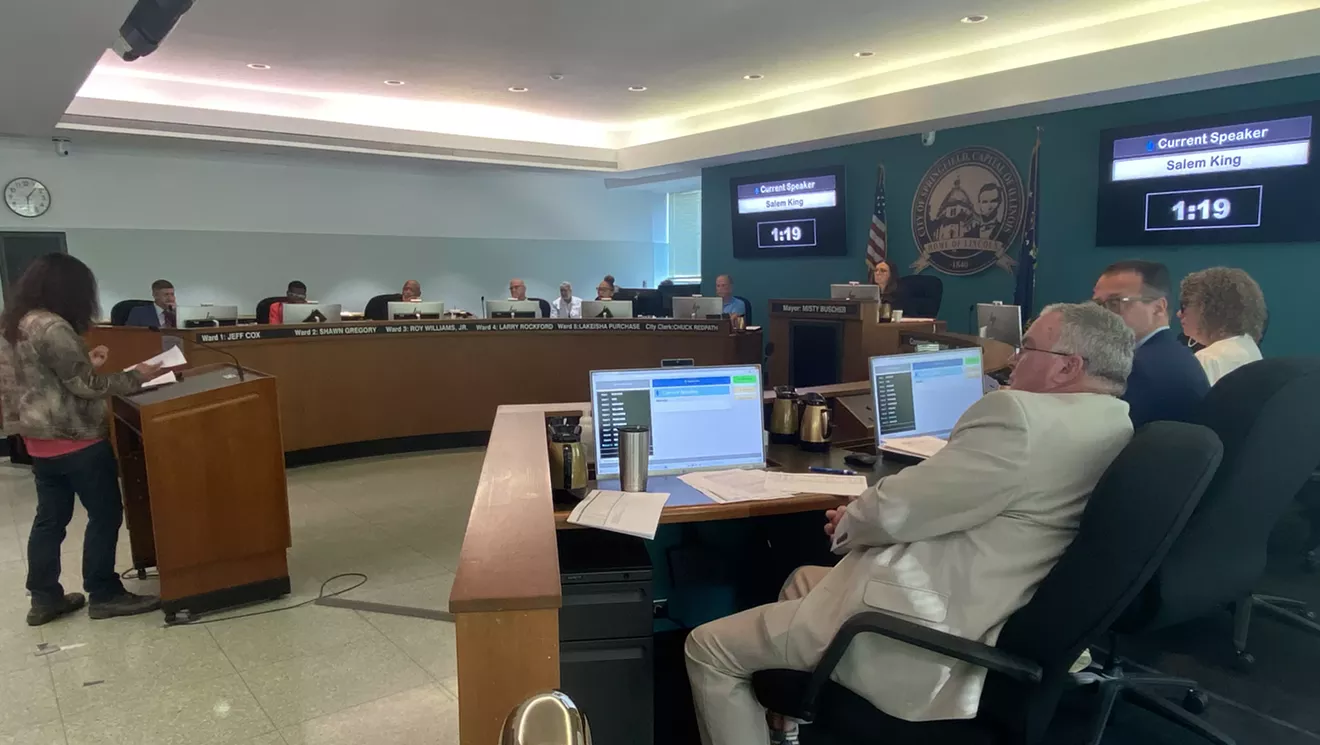
PHOTO BY DEAN OLSEN
Salem King speaks in front of the Springfield City Council July 1 in favor of forming new grant programs funded through the Madison Park and Far East tax increment financing districts.
The Springfield City Council passed two ordinances amending existing Tax Increment Financing (TIF) districts last night, putting an end to a weeklong debate. The ordinances each passed 9-1, with Ward 7 Ald. Brad Carlson as the dissenting vote in both cases.
The two TIFs, which have existed for years in the Madison Park Place and Far East districts, were both amended to include direct payment to contractors and reduce match requirements for those receiving funds. The council members supporting the bill said these changes will reduce barriers created by the current reimbursement model and speed up the process for home and business improvement projects.
Ward 2 Ald. Shawn Gregory, the primary sponsor of both bills, gave the example of a homeowner paying $5,000 or $9,000 out of pocket to fix their roof, which he said can slow down or entirely stop the process.
“By us having the ability to pay contractors directly, it can speed up the process and get things done more quickly,” Gregory said.
Carlson said he was “all for this TIF” but voiced multiple concerns with the changes, including that he hoped that homeowners would understand that property taxes would eventually rise as a result of the increased value of their homes.
He also expressed concerns related to the ability to evaluate the economic success of the TIFs, saying that “changing some rules” at the end of the lifecycle of the TIF would make it harder for experts to measure the impact. And, Carlson said he wanted to see investment from the homeowners themselves.
“I’d like to see a little more skin in the game,” Carlson said.
It was a statement that garnered strong disagreement from some of his colleagues.
“These are business owners and homeowners,” said Ward 6 Ald. Jennifer Notariano. “I don’t know, that sounds like skin in the game to me. They are living there, paying taxes to be there. Skin in the game? You got it.”
“Skin in the game is fine, but some people don’t even have skin, we’re just that broke,” added Ward 3 Ald. Roy Williams Jr.
Finally, both Carlson and Ward 10 Ald. Ralph Hanauer said they feared that the ordinance would tie up money now, making it unavailable for future projects on the east side. Carlson hypothesized about potential yet undisclosed projects that might be brought forward from the Springfield Sangamon County Growth Alliance or the Black Chamber of Commerce.
Williams objected to the hypotheticals, saying such a project had not materialized in all his time on the board.
“I got here in 2019, it hasn’t (come),” Williams said. “This little bit of stuff we’re trying to do, we’re trying to generate some energy and maybe make ourselves look better so that we attract the bigger project or attract developers.”
Should a future project demand it, the council always has the flexibility to reallocate any unused funds that have not been applied for and distributed to home and business owners, said Ward 9 Ald. Jim Donelan.
Also, low-income homeowners in non-TIF zones across the city can look forward to an ordinance aimed at reducing the cost matching threshold and finding alternate financing options, according to Ward 8 Ald. Erin Conley, who said she was exploring options with the Office of Planning and Economic Development.
Hanauer presented a report from the Office of Planning and Economic Development showing that the majority of TIF money and other grant funds in the past five years have gone to Wards 2, 3 and 5. Hanauer noted that some wards, such as his, were not eligible for TIF funds, saying he wanted to counter the perception that the west side was taking money away from the east side.
Per state statute, an area must be designated as blighted to create a TIF district. Likewise, many state or federal grants award funds within a targeted census tract, which is a specific geographic area that has been identified as having a high level of economic distress.
In response, Gregory said he hoped for a day when his ward no longer met the conditions of blight required to receive TIF money.
“I dream of a time where we don’t need no grants because we’re poor or living below the poverty line,” Gregory said. “I truly do envision those days, not only in my ward, but in every ward that needs it.”


